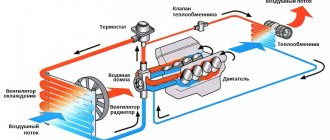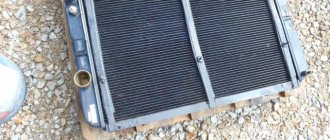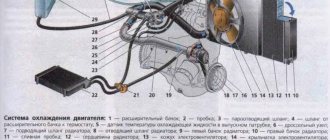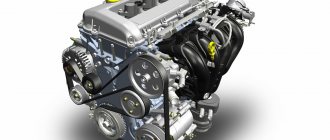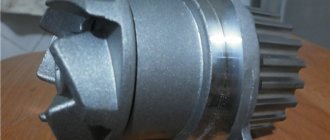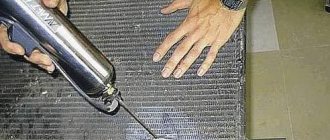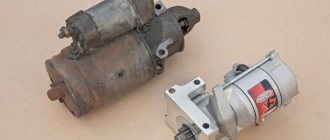- Radiator VAZ 2114
- Radiator selection
- Aluminum
- Copper
- Radiator VAZ 2114: Which brand to choose
For greater convenience and comfort of both the driver and passengers, VAZ cars (and, perhaps, almost all modern cars) are equipped with a heating system. Not the least role in it is played by the DaAZ 2114 radiator, which is responsible for transferring heat directly to the car interior. We will talk about how to find out whether the radiator is working properly, as well as what to do if it breaks down in today’s article.
Radiator DaAZ 2114
see also
Comments 22
Just take the DAAZ, I myself encountered such a problem, I took the PRAMO radiator for a year and it started to drip. So you better take DAAZ
Thanks to everyone who responded, closer to the holidays I’ll take it and change it! I just asked about the main radiator and the heater radiator was trashed)
I took the Lada in its original packaging. For 2 years everything is fine.
Only DAAZ original
In our store it costs 2150.
Definitely only the original DAAZ. Buy it from serious stores, they have a guarantee, and you can check the radiator via SMS for authenticity.
I took the DaAZ in January, paid 1.5k, the flight was normal
Install Daaz costs 2 years
just as an idea. discard taps and pipes. And get heat immediately when you turn on the ignition)))
A tempting idea. What is this radiator from? I wonder if there are installation examples on the drive. In the queries I entered...naked.
interior radiator from Ford 3. There are no installations for cans yet. I'm thinking about installing it myself. Apart from pulling power cables to it, there should be no problems. And I’m thinking of putting the switch on the speed regulator.
It turns out to completely throw out the radiator with liquid heating, loop the hoses and put an electric radiator in the stove instead. If, as they say, it’s the fire that heats it… then it’ll be great. The only thing is how it will behave when heated for a long time, well, if we let it ride all day. Something will happen to the electric heating element and how long will the radiator last with such operation.
So I’m thinking about installing some kind of regulator so that you can regulate the heating temperature by changing the voltage on it
Well, a regulator is necessary anyway. As I understand it, the stove has 3 heating circuits. Weak, medium and strong. You can also turn on the speed of the stove fan to get power.
It turns out to completely throw out the radiator with liquid heating, loop the hoses and put an electric radiator in the stove instead. If, as they say, it’s the fire that heats it… then it’ll be great. The only thing is how it will behave when heated for a long time, well, if we let it ride all day. Something will happen to the electric heating element and how long will the radiator last with such operation.
What about a regular radiator? What starts to heat up after 10 minutes? So, in my opinion, autostart will be cheaper than this electric radiator.
With the usual everything is fine. The heat in the car is good. Shiga is available with auto start. It’s just a good idea to implement and there won’t be any problems later if the radiator leaks. There is an electric radiator in the cabin and all the liquid circulation is only under the hood.
If it were good, it would have been used for a long time. During repairs, I installed a 1.5 kilowatt air heater in the cabin. And I’ll say it heats much worse than a stove. Two or two and a half kilowatts will be approximately equal to the power of the stove. How much gasoline will be spent on cranking the generator under such a load? In the meantime, the free, relatively warm coolant will warm the street.
just as an idea. discard taps and pipes. And get heat immediately when you turn on the ignition)))
You will be tired of feeding this RTS. And compared to a standard stove, it loses at least three to four times.
OVEN RADIATOR
Often the reason for the lack of heat in the car is the heater radiator on a VAZ. The VAZ 2114 heater radiator is designed to transfer heat from the coolant passing through it into the car interior. Over time, this element becomes clogged with dirt and debris, and coolant does not pass through it. Someone is trying to flush the system by adding special chemical liquids to the antifreeze, but practice shows that nothing better can be thought of as a replacement. Replacement is more expedient, the radiator is generally inexpensive, and removing and installing it again is quite troublesome. The part is also replaced if antifreeze begins to leak in the cabin. All stove radiators (RS) can be divided into three types according to the material of manufacture and type of manufacture:
- Prefabricated aluminum;
- Non-prefabricated aluminum;
- Copper (brass).
The aluminum radiator of the Dimitrovgrad Automotive Aggregate Plant (abbreviation DAAZ) is considered factory-made.
In turn, aluminum parts may not be original. As a rule, they are significantly cheaper than factory spare parts, but the quality varies.
Car owners do not have a consensus on which cooling radiator is better to install in the stove on a VAZ 2114, but original spare parts are definitely the most reliable. Among the manufacturers of parts we can note:
The cost of all radiators is different; copper parts are considered the most expensive. You should know that the radiator of the VAZ 2115 (VAZ 2113) stove is absolutely identical to the stove element of the 2114 model, so they are completely interchangeable. In addition, the spare part can be easily installed in VAZ models 2108-09-099, as well as ZAZ 1102 (Tavria), without any modifications.
There are many negative reviews about the RP company LUZAR. Buyers note that they do not heat the interior well and often leak. Therefore, it is worth considering whether it is worth purchasing the products of this company.
Radiator selection
The most popular radiators are aluminum, and this is not surprising, because they cost much less than copper (or brass), and they are much easier to find on sale. Based on the type of cooling grille, they can all be divided into two large groups: prefabricated (inside of which there are sets of plates with tubes fixed in them through which coolant circulates) and non-prefabricated (a special corrugated tape is installed inside them).
Aluminum
At the same time, all aluminum radiators (which include the DAAZ heater radiator for the VAZ 2114) have both significant advantages and certain disadvantages.
The first include:
- low cost, especially for prefabricated models;
- high thermal conductivity, ensuring rapid heating;
- light weight;
- high structural rigidity, making them quite resistant to external influences.
As negative points it is worth noting:
- rapid cooling (again due to high thermal conductivity) - when the engine is turned off, the car cools down quickly;
- short service life (compared to copper models);
- low maintainability (soldering aluminum in garage conditions is extremely difficult).
It is also very important to note that it is impossible to use ordinary water as a coolant (as domestic motorists sometimes do) with an aluminum radiator installed, since it will quickly cause corrosion.
Copper
Speaking about copper radiators, it is worth saying that according to the principle of their design, they are close to aluminum non-assembled radiators, but at the same time they have much better heat transfer.
Their advantages include:
- better heat retention, slow cooling;
- greater efficiency due to higher heat transfer;
- high maintainability (copper can be soldered even in “field” conditions);
- long service life.
But, despite such important advantages, they also have the following serious disadvantages:
- high cost (in most cases it is twice the cost of aluminum models);
- very long heating (after turning on the stove, the interior will not warm up soon);
- low efficiency when the engine operates at low speeds.
It is because of these shortcomings that copper radiator models are considered obsolete from a moral point of view, and increasingly even large manufacturers are installing aluminum devices on their cars.
That is why, if you are faced with the problem of choosing whether to take a radiator made of copper or aluminum, it is better to give preference to the latter option. At the same time, not only the material itself is important, but also the overall quality of workmanship.
CHOICE
So which heater radiator is better, copper or aluminum for a VAZ 2114? Let's consider the disadvantages of each manufacturing material.
Copper or aluminum?
What can you say about the aluminum stove radiator? Aluminum has good thermal conductivity and therefore heats up quite quickly. True, it also cools down almost immediately. Therefore, when you turn off the engine, the cabin of the 2114 will become cold after a while.
Which stove radiator to choose: copper or aluminum
Many people ask the question: which stove radiator is better - copper or aluminum? There can be no definite answer here; each has its own disadvantages and advantages.
Operating principle of the heater
To make the right choice, you need to know the principle of operation of the heating system in a car.
Heat enters the car interior from the engine, this is a side effect of its operation. Heat is generated as a result of fuel combustion and from rubbing surfaces. To remove heat from very hot parts, the engine is equipped with a cooling system, an integral part of which is interior heating. Therefore, the hotter the engine gets, the better the heating. Hot coolant is supplied to the heater core, and the fan, passing air through it, dissipates heat throughout the cabin.
The temperature of the air leaving the deflectors is regulated by a tap located on the line between the motor and the stove. This is a regular shut-off valve with a mechanical or electrical drive; it regulates the amount of coolant that passes through the heater (by increasing the temperature on the control unit, the valve opens more; by decreasing the temperature, it closes). How the stove will work greatly depends on its operation. If it does not work correctly (does not fully open the passage for liquid), then it will be cold in the cabin.
Also an important factor is the temperature “overboard”; even a well-functioning heater in cold weather will heat a little worse, since the liquid does not heat up enough, because of this the heating becomes insufficient. The thermostat has a big influence: if it doesn’t work correctly, then don’t install any radiator, and cold air will blow from the deflectors. First you need to check the proper functioning of the entire system as a whole, and then think about replacement.
Device
The radiator of the heating system is similar to its older brother from the cooling system. And their functions are similar, only the large one releases heat into the atmosphere, and the small one into the cabin. Both have two tanks in their design, which are connected to each other by tubes. Plates are attached to the tubes by soldering, increasing the cooling area (the more plates, the greater the heat transfer). Therefore, when choosing, you need to pay special attention to the number of plates. This can be done by placing both copies together and visually inspecting the density of the plates. Which radiator has a higher density, the heat transfer is higher. Liquid inlet and outlet pipes are attached to one of the tanks. Some models are equipped with places for attaching to a car.
Copper stove radiator
- Copper has greater thermal conductivity than aluminum. And with an increase in thermal conductivity, heating improves.
- Maintainability. Copper is soft and will not be damaged by minor dents. Even if cracks appear, burst tubes can be soldered, leaving thermal conductivity unchanged.
- The copper radiator is equipped with a tank made of the same material, which significantly improves its performance characteristics.
Flaws
Aluminum radiator
- The first and most important advantage will be its price. It is almost two times smaller than that of its copper counterpart.
- With an increased number of plates (increased cooling area), the heat transfer will be less than that of copper, but not so significantly.
- Prevalence in the new car market. Cars of recent years produced in our country are equipped with aluminum radiators.
Flaws
- The low thermal conductivity of the material is the biggest disadvantage.
- Non-repairability: if the tubes are damaged, they cannot be soldered, and the entire assembly has to be replaced. A plastic tank can be damaged by the slightest blow. Some copies may have a crack in the tank out of the box. There are “craftsmen” who change tanks, but this is unreliable, and there is a high probability of failure of the entire stove.
- Susceptibility to corrosion. Aluminum is more susceptible to corrosion, which leads to poor heat transfer and the formation of smudges and failure of the entire interior heating system.
What mechanical failures can occur in the cooling system?
Usually, due to unexpected breakdowns in the engine cooling system, overheating can occur and as a result, the car engine breaks down.
As usual, any of the following parts may fail to work:
Radiator. Possible leakage from the radiator is leakage through aluminum tubes or plastic tanks. It happens quite often that the plastic parts of the outlet under the return hose of the expansion tank break off.
But there is another problem that probably causes the motor to overheat - clogging (clogging).
Pipes. If the pipes are old and have lost flexibility over the years, this is also a possible cause of antifreeze leakage.
Thermostat. The necessary operation of the valve in the thermostat depends on its correct operation, and in the internal combustion engine itself the following may occur:
- If overheating occurs, the antifreeze boils away through the expansion tank.
- The car does not warm up to the required temperature. Subsequently, the car drives unstably, and in winter the car dealership is cold even with the heater on.
Choosing a heater radiator for a VAZ 2114
Which heater radiator is better for a VAZ 2114? The question is more relevant than ever. All owners of the fourteenth understand that the heating system leaves much to be desired. Not only does the car not warm up enough (although in most cases it is difficult to do anything about the temperature regime in many regions), but the heater also tends to fail, antifreeze begins to leak, and so on. As a standard, especially on first-generation Samaras, VAZ used copper radiators. Relatively recently, a domestic manufacturer adopted foreign experience and began to use aluminum heaters. And yet, which is the best heater radiator for the VAZ 2114 still needs to be figured out.
Heater radiator VAZ 2114
Radiator VAZ 2114: Which brand to choose
As was just said, the brand of the radiator plays an important role in choosing a radiator, because when buying a device from an unknown manufacturer, you can hardly expect durability and proper operation.
The most popular radiator options (according to experienced motorists) are:
- "Orenburg radiator";
- Fenox.
Prices for these brands may differ quite a bit, but their quality is approximately at the same level, and therefore you can give preference to any radiator from the list above.
It is also worth noting that the heater radiator for the 15th model is fully compatible and interchangeable with the heater radiator of the 14th model.
Concluding the conversation about choosing a radiator, it should be said that there are many negative reviews about LUZAR products. Despite their good performance and high thermal conductivity, they leak quite often, and therefore you should think carefully before choosing this manufacturer.
Aluminum or Copper
Obvious advantages of an aluminum radiator:
- the presence of side ribs is much larger than that of a competitor
- the width of the channels for air flow is greater (this fact can significantly reduce the risk of breakage, and also increases the efficiency of heat supply at idle)
The obvious disadvantage of an aluminum radiator:
- heats up very quickly and cools down just as quickly (heat transfer is 209.3 W/m.deg)
- As soon as a leak is discovered, it needs to be replaced; such a unit cannot be resuscitated
Obvious advantages of a copper heater:
- heats up for a long time and cools down just as long (rather, the second part of the radiator’s property is a plus), heat transfer is 389.6 W/m.deg
- can be reanimated: as soon as a leak appears, you just need to solder the hole
Obvious disadvantages of a copper heater:
- fewer ribs than the competitor
- the channels are small and narrow, they tend to clog quickly, which impairs warming up and adds more reasons for repairs
- At idle it barely warms up.
- it is difficult to find a high-quality copper heater, since almost everyone who makes units from such material uses impurities and can paint the original material, which naturally reduces the heat transfer property
Today, aluminum radiators are clearly more popular than copper ones. And this is primarily due to the difficulty of finding a high-quality copper unit. And if luck smiles on you, then the price for a copper radiator of a VAZ 2114 stove will be many times higher than for an aluminum radiator. Average. You will get aluminum from 1000 rubles, and copper from 1700 rubles! This is still good, if you install it yourself, the radiator replacement service will cost 800-1000 rubles, on average. By the way, if you can’t solder a leaking copper heater on your own, then taking it to the service center every time will be very expensive; you’ll be able to save up for a limousine. And since all VAZ spare parts tend to be imperfect, keep in mind that you will have to deal with this one way or another. So think about whether it’s worth buying a copper radiator for the VAZ 2114 stove.
How to independently choose a heater radiator for a LADA car
Which radiator to choose for the stove on a VAZ 2114? This question is gaining relevance in connection with the approaching winter. It's no secret that not all domestically produced cars have a good heater. Let's try to figure out which radiator to choose:
Copper radiator.
Immediately after purchase, the copper radiator has a heat output of 389.6 W/(m. deg).
The properties of copper are such that such a radiator takes a long time to heat up and takes a long time to cool down. The number of fins in a copper radiator is smaller than in an aluminum one, and the cross-section of the channels is smaller. Therefore, they clog faster and the stove blows cool air at idle. Most often, this is what VAZ owners complain about. The advantages of a copper heater radiator include its maintainability. This is where the advantages end. And the disadvantages begin: recently, manufacturers have been saving on raw materials and using impure copper. Some paint radiators to give them a marketable appearance, but this reduces the heat transfer of such a radiator. Lately it has been very difficult to find a high-quality copper radiator.
Aluminum radiator.
The heat output of the aluminum radiator is 209.3 W/(m deg).
This radiator heats up quickly and cools down quickly. The number of fins in an aluminum radiator is much greater than in a copper one, which is a definite plus. The cross-section of channels in an aluminum radiator is also larger than that of a copper radiator. Thanks to this, they do not clog longer and have greater heat transfer. The disadvantages of an aluminum radiator include its non-repairability in case of leakage.
So which radiator should you buy?
Just a few years ago, the answer to this question would have been: copper. But time passes and today it is difficult to find a high-quality copper radiator. Therefore, our choice at the moment: aluminum.
However, we do not recommend buying painted radiators, because... their heat transfer is lower and an unpleasant odor may appear in the cabin.
Of the companies, we do not recommend buying heater radiators manufactured by Luzar. There are too many negative reviews about them.
How to prepare the VAZ 2114-15-13 stove for winter.
In order to avoid problems with the interior heater in winter, we recommend doing the following:
- Replace the coolant and flush the entire cooling system.
- Replace the interior heater radiator with a new one.
- Replace the engine cooling radiator with a new one
- Change the pump.
- Remove air from the cooling system.
These steps will help you avoid heat problems in the winter. Replacing radiators will help avoid contamination of the coolant, and replacing the pump will guarantee its normal circulation in the system.
Video on choosing a radiator for VAZ cars:
remont2114.ru
Specific examples
The painted copper radiator on the VAZ 2114 deserves special attention in the debate about which heater radiator is better, copper or aluminum. By the way, these are made by an office called “LUZAR”. There is no need to take such units: they are very cold, and have minimal heat transfer! But such devices have a full year warranty.
Why is everything so bad with Luzar? An autopsy will show: the rubber band, which is located next to the passage channels of the ribs, simply becomes damp after a relatively short period of time (less than a year) and the same short mileage. Another big disadvantage of Luzarov radiators is that the pipes are separated from each other, this reduces heat transfer, but makes the cost advantageous.
In general, it is now difficult to find a zero radiator that is relatively recent. Factory junk will crumble, radiators from the manufacturer are not always of decent quality. Therefore, the guideline you can choose is very simple (when choosing a radiator): it just has to be working and not clogged. And what material it is made of is the tenth thing.
Another company, DAAZ, has proven itself very well. There is only one minus - try to find it, and then try to find the original. By the way, the heat output of the Daazov heater is slightly lower than the factory one in the VAZ. And in terms of quality it clearly wins.
Another example is a heater from Oberkraft. The factory carefully approaches the testing process of the unit, which is why it is covered by a good warranty (one year). This device is made of aluminum alloy, which meets modern quality standards. An obvious advantage is the good, uniform distribution of heat throughout the cabin (apparently, they decided not to skimp on pipes), but considering the price, you can’t say that this is an easy purchase – from 1,800 rubles. But there are justifications for this price:
- Corrosion resistant
- Relatively light in weight
- Very important: resistant to temperature changes!
- Robust design
- Excellent and uniform heat dissipation.
In winter, even the highest quality stove will play tricks in terms of heat output. We offer a couple of good tips on how to make the interior warmer:
- You need to change the antifreeze and rinse the entire cooling system - this will remove all the debris in the tubes, making it easier for air to enter the cabin
- A great way to improve the microclimate is to install a new stove!
- You can also replace the cooling radiator with a new one - this will save the antifreeze from premature fatigue
- An option is to replace the pump, because it is responsible for the stability of coolant circulation at idle
- Run all the pipes and get rid of air pockets
Cooling system of an injection engine on a VAZ 2114 (diagram)
Alas, the build quality of the VAZ 2114 radiator and the cooling system as a whole leaves much to be desired, which is why it can fail over time. The main disadvantage of the OS (cooling system) of the “fourteenth” model is the need for constant monitoring, regular maintenance and repair.
The solution to these issues is complicated by the fact that the cooling system of the injection engine on the VAZ 2114 is quite complex and includes 28 elements. The most convenient way to get to know them is on a special chart.
Cooling system design
The VAZ 2114 is equipped with forced circulation CO. As a cooling system, you can take the most common substances antifreeze and antifreeze. In emergency cases, you can use water instead of specialized automotive substances.
Note: In winter, using vehicles filled with water instead of special liquids can lead to freezing of the engine. And in other seasons, during prolonged use of vehicles, the cooling jacket in the block and cylinder head begins to corrode the engine on the water, and rusty sediment accumulates.
The engine cooling system consists of the following elements:
How the OS works
The electric fan is located on the electric motor shaft. Depending on the indicators of the sensor, it is turned on or off. One of the main elements of the OS is a thermostat valve with a storage tank , which senses changes in air temperature.
If the fluid temperature is around 87 degrees, the main valve turns on and sends fluid through the large circuit. At a temperature of 102 degrees, the valve stops at 8 mm.
Replacing the coolant
To normalize the cooling system on a VAZ 2114, sometimes it is enough to replace the coolant. To determine when this needs to be done, you should know some nuances:
- The effective life of antifreeze is 2 years, and antifreeze is 5 years;
- Typically, replacing antifreeze is required after a mileage of 20-40 thousand kilometers, depending on operating conditions;
- A changed color of the composition indicates that it needs to be replaced.
antifreeze as a liquid , since it has a long service life and does not wear out the system so intensively. in favor of antifreeze is its affordable price.
Before adding new fluid, the system should be flushed. For this:
- Drain all existing coolant from the system;
- Screw the plugs tightly;
- Fill with high-quality distilled water to the maximum;
- Start the engine and bring it to operating temperature;
- The revolutions should be about 3 thousand. Avoid overheating the engine;
- After turning off the engine, leave the car for 7 minutes, after which the water is drained. If the system is heavily contaminated, the procedure must be repeated until completely clean distillate begins to pour out.
Partial repair or complete replacement of the radiator
Below we will describe in detail the main features that may arise during the repair work.
Flushing the cooling system
A complete replacement of the radiator may occur when clogs cause the engine to overheat.
But before you start replacing the radiator, you can first try flushing it completely with CO from the engine of the vehicle. Quite often it turns out that flushing helps a lot and the car’s engine stops overheating.
Step-by-step instructions for proper rinsing:
- To do this, vehicles must be parked on a perfectly flat surface.
- Next, the top cap of the expansion tank is unscrewed.
- Then the coolant is drained, while unscrewing the lower plug in advance.
- The next step should be to twist the water plug from the cylinder tank.
- It passes between the engine and the fan near the starter, then the antifreeze drains from it.
- Water is poured into the central system, and the lids are subsequently screwed on.
- After completing the steps, you need to let the engine run for a certain time and finally empty the water from the tank. If it is very dirty, then this process should be repeated in the same sequence. If necessary, in case of large contamination, washing is carried out repeatedly until the water becomes clear.
- After flushing, fresh coolant is poured into the reservoir. We should not forget that on a VAZ 2114 CO is 7.8 liters and the entire total volume of antifreeze does not fit - this only means that a plug has appeared in it from the air. To avoid engine overheating, it is necessary to fill the entire tank as much as possible.
- Most professionals insist on washing the engine while it is not warm. This is necessary so as not to get burned on the antifreeze later. On the one hand, if you look at it, this is the best option. But there is one “But”: if the engine is not warmed up, the dirt that has accumulated in it will settle on the walls and the likelihood of achieving an effective washing result will be very low.
It is necessary to carry out this work in waterproof clothing and special gloves, but even with such self-protective actions, unusable substances must be drained very carefully. The service life of antifreeze and antifreeze is set by manufacturers to range from 2-5 years.
Radiator replacement
But if washing turns out to be useless, then it should be replaced and this is not a difficult task.
- First, remove the expansion tank cap.
- Then the antifreeze is drained from the radiator itself and the cylinders. Before this, you need to take care and take unnecessary containers to drain old substances into them.
- Next, the air filter housing is dismantled, because in the future it will be very difficult to remove the old radiator.
- The next step is to disconnect the plug from the electric fan, and you need to unscrew the 2 screws that hold it in place and remove the assembly.
- Then the clamps are loosened from the side where it is more convenient to do this and the pipes are subsequently disconnected.
- 2 screws are removed from the top, which secure it to the main body frame.
- Tilt the body towards the engine itself and then easily remove the required part. Now the removal of the radiator is complete.
- Reassembly is carried out in the reverse order, after which fresh antifreeze is poured into the tank and the engine is started.
Radiator repair
If the owner of the car suddenly has a desire to make minor repairs to the engine with his own hands, this very often happens and is considered a necessary measure.
- If you urgently need to go to the right place only in emergency cases.
- In the case when the family budget did not plan to replace the radiator.
All plastic car parts can be treated with a special epoxy resin or simply soldered. But if the leak occurs through the honeycomb in such a situation, you can resort to a special chemical composition by adding antifreeze and subsequently blocking the leak site.
But there is a high probability that such chemistry may complicate the flow of coolant through the central system.
And that’s just why DIY repairs are considered very expensive, and a lot of time is spent on it. Today in stores you can buy an expensive version of a new radiator made of copper - it is much easier to repair.
Why the OS does not work
If you don’t know which cooling radiator is best to choose for the VAZ 2114, look at the existing one. Buy an analogue from the manufacturer, or purchase a device with the closest characteristics.
The fourteenth model is equipped with an aluminum radiator with two additional tanks. The radiator design includes:
- Radiator;
- Upper tank with pipes;
- Bottom tank with pipes.
Radiator replacement
The replacement procedure itself is as follows.
- Unscrew the plug from the expansion tank and the cylinder and radiator plugs.
- Drain the coolant into a large container.
- Disconnect the radiator ventilation system from the battery.
- Remove the silicone pipes of the VAZ 2114 cooling system by disconnecting them from the radiator and tank.
- Remove the mounting bolts from the casing.
- Hold the radiator and remove the skin and fan together.
- This will completely free the radiator, so you can easily replace it with a new one.
- Assembly of the unit is carried out in reverse order. After replacing the radiator, start the engine and check the efficiency of the new unit.
Order of Operations
If the car has a low seating position or the coolant drain tank is large, work should begin by lifting the car with a jack. The radiator is installed on the TV along with fog and regular headlights. Work should only begin with a cold engine. If the engine is hot, be sure to wait until it cools down.
Now you can get started:
- After removing the plug from the expansion barrel, the working fluid is drained into a container. It is necessary to drain all the antifreeze that is in the cooling system.
- Now you need to dismantle the filter.
- The radiator must be removed together with the electric fan. To do this, you need to disconnect the power supply to the cooler. Now you need to unscrew the pressure plate and remove it.
- Now you need to remove the inlet and outlet hoses from the pipes. To do this, loosen the fastener clamp.
The radiator with fan is tilted towards the engine and removed. Attention! Before pulling out the fan, you need to disconnect the wires. They are usually located at the bottom of the device. This is necessary in order to maintain the functionality of the wiring.
- Now you need to disconnect the fan from the radiator. To do this, use a 10mm wrench to unscrew 2 nuts. The fan must be removed along with the casing.
- Installation of the radiator is carried out in the reverse order to that described above. It begins with switching the new node and the fan. Important! Before replacing, make sure that there are 2 rubber cushions. If they are missing, install new ones in the crossmember holes. If they are in place, then the installation of the new unit is carried out on them.
Radiator repair
In some cases, the radiator can be repaired, so you don’t have to buy a new spare part.
Most often, liquid leaks at the junction of plastic and metal parts. If there is a small leak, you can pour a special liquid with a coolant mixture inside the radiator. Thanks to its special composition, this product will seal the defects that caused the leak. If the damage is serious, repairs will no longer save the situation; you will still have to replace the radiator.
To check the tightness of the radiator, you can conduct a simple experiment at home.
- Fill the bathroom with enough water to submerge the radiator.
- Close all pipe openings tightly.
- Lower the radiator under water about 30-50 centimeters. Apply a pressure of 0.2 MPa to it.
- Watch what happens. If bubbles appear, the system is not sealed and needs to be repaired or replaced.
Do not even try to repair the radiator after side or frontal impacts in an accident. In such situations, he suffers first of all, and no clogging liquids will help you.
Thermostat problems
When the temperature reaches 95 degrees Celsius, the liquid begins to flow through the thermostat. Due to the operation of this unit, the engine requires a minimum of time and resources to warm up. The thermostat is located between the radiator and the engine.
Most often there are two types of faults.
- The valve closes. If the engine is not warmed up, it is difficult to maintain speed. It may simply stall.
- The valve opens. During frosty periods, you can operate the car, but you must turn on the heating at maximum speed. Otherwise, the power unit will simply overheat.
If you are unable to move the valve while repairing the thermostat, don't be afraid to lightly tap the housing with a simple screwdriver. This will solve a common problem.
When the thermostat is completely disassembled, the pipes are hermetically sealed, which will prevent coolant leakage. Only after this can you start working.
In general, the choice between antifreeze and antifreeze should not be a problem for you. Choose antifreeze. Although it is more expensive, it lasts longer and allows you to minimize possible problems with wear and tear of the cooling system. The imaginary savings due to antifreeze are not called that for nothing. In the future, you will pay much more to fix the damage caused by the use of antifreeze.
